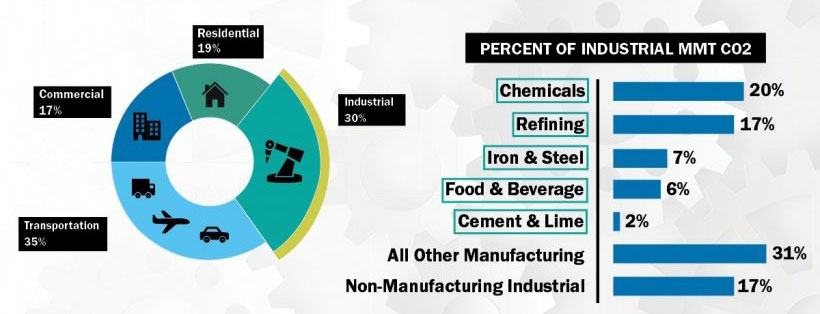Feds earmark $100M to decarbonize cement, companion industries

Sources: U.S. Department of Energy; CP staff
The Department of Energy’s (DOE) new “Industrial Decarbonization Roadmap” identifies key pathways—Energy Efficiency; Industrial Electrification; Low Carbon Fuels; Carbon Capture, Utilization and Storage—to reducing carbon dioxide emissions in Cement, Iron & Steel, Chemicals, Food & Beverage, Refining and other manufacturing sectors that collectively account for 30 percent of the United States’ annual CO2 load.
Portland Cement Association Senior Vice President of Government Affairs Sean O’Neill recently joined Steel Manufacturers Association, American Iron & Steel Institute officials and other industry or government agency representatives at DOE headquarters for a Roadmap unveiling and roundtable. The gathering also saw announcement of a $104 million decarbonization technology funding opportunity.
ENERGY-RELATED CARBON DIOXIDE EMISSIONS BY U.S. ECONOMIC SECTOR

The DOE Office of Energy Efficiency and Renewable Energy tracks carbon dioxide emissions in the “Industrial Decarbonization Roadmap,” citing data from the U.S. Energy Information Administration’s “Annual Energy Outlook 2021.” Construction, Mining and Agriculture are grouped under the Non-Manufacturing businesses (lower right) responsible for 17 percent of the overall Industrial category CO2 emissions.
Roadmap authors acknowledge the fixed CO2 aspects in cement calcination and clinkering phases, but cite among prospective decarbonization measures for the industry and downstream concrete or construction interests:
- Increase use of low carbon binders and natural supplementary cementitious materials to cut the carbon-intensity of concrete;
- Evolve processes to reduce waste, including circular economy approaches, for concrete construction;
- Improve materials and cement plant energy efficiency with deployment of breakthrough technologies and innovative chemistry solutions; and,
- Expand use of Carbon Capture, Utilization and Storage technologies.
“America’s industrial sector is critical to our economy and daily lives, yet is particularly difficult to decarbonize,” said roundtable leader Energy Secretary Jennifer Granholm. “The Roadmap will help put the nation on the path to a cleaner industrial sector that benefits workers and revitalizes communities, while providing a healthier environment.”
“The Roadmap and funding opportunity couldn’t come at a better time, building on the historic funding in the Inflation Reduction Act and ensuring the clean energy economy is made in America,” added White House National Climate Advisor Gina McCarthy. “Building a cleaner, more prosperous future requires harnessing American innovation and ingenuity, and investing in our workforce while reducing pollution burdens.”
Related article
Cement, concrete, and carbon conversation turns to intellectual honesty and plausibility